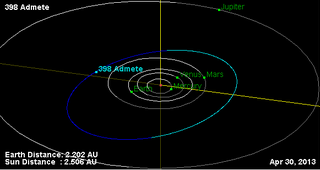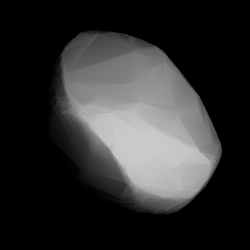
Peitho is a main-belt asteroid. It is probably an S-type asteroid, suggesting a siliceous mineralogy. It was discovered by R. Luther on March 15, 1872, and named after one of the two Peithos in Greek mythology. There have been two observed Peithoan occultations of a dim star: one was in 2000 and the other in 2003.

Lachesis is a large main-belt asteroid. It was discovered by French astronomer Alphonse Borrelly on April 10, 1872, and independently by German-American astronomer Christian Heinrich Friedrich Peters on April 11, 1872, then named after Lachesis, one of the Moirai, or Fates, in Greek mythology. A Lachesean occultation of a star occurred in 1999 and was confirmed visually by five observers and once photoelectrically, with the chords yielding an estimated elliptical cross-section of 184 × 144 km.

Medusa is a bright-coloured, stony main-belt asteroid that was discovered by French astronomer J. Perrotin on September 21, 1875, and named after the Gorgon Medusa, a snake-haired monster in Greek mythology. It is orbiting the Sun at a distance of 2.17 AU with a period of 3.21 years and an eccentricity of 0.065. The orbital plane is tilted slightly at an angle of 0.94° to the plane of the ecliptic.

Eos is a large main-belt asteroid that was discovered by Austrian astronomer Johann Palisa on January 18, 1882, in Vienna. In 1884, it was named after Eos, the Greek goddess of the dawn, to honour the opening of a new observatory that was hoped to bring about a new dawn for Viennese astronomy.

Carolina is a sizeable Main belt asteroid. It was discovered by Austrian astronomer Johann Palisa on 28 November 1883 in Vienna, and was named after Caroline Island, now part of Kiribati in the Pacific Ocean. This asteroid is orbiting the Sun at a distance of 2.88 AU with a period of 4.89 yr and an eccentricity (ovalness) of 0.06. The orbital plane is tilted at an angle of 9.0° to the plane of the ecliptic.
Oppavia is a sizeable Main belt asteroid. It was discovered by Austrian astronomer Johann Palisa on 31 March 1886 in Vienna and was named after Opava, a town in the Czech Republic, then part of Austria-Hungary, where Palisa was born. It is orbiting the Sun at a distance of 2.75 AU with an orbital eccentricity (ovalness) of 0.077 and a period of 4.55 yr. The orbital plane is inclined by an angle of 9.47° to the plane of the ecliptic.
Geraldina is a large Main belt asteroid. It was discovered by Auguste Charlois on October 3, 1890, in Nice. The origin of the name is unknown. It is orbiting the Sun at a distance of 3.21 AU with a period of 5.74 yr and an eccentricity (ovalness) of 0.057. The orbital plane is tilted at an angle of 0.73° to the plane of the ecliptic.
Etheridgea is a large main belt asteroid. It was discovered by Auguste Charlois on 1 April 1892 in Nice. The meaning of the name is unknown. This asteroid is orbiting the Sun at a distance of 3.02 AU with a period of 5.26 years and an eccentricity (ovalness) of 0.10. The orbital plane is tilted at an angle of 6.05° to the plane of the ecliptic.
May is a large Main belt asteroid. It was discovered by Auguste Charlois on 28 November 1892 in Nice, and was named for the German author Karl May. This asteroid is orbiting the Sun at a distance of 2.97 AU with a period of 5.12 years and an eccentricity (ovalness) of 0.067. The orbital plane is inclined at an angle of 9.7° to the plane of the ecliptic. During its orbit, this asteroid has made close approaches to the dwarf planet Ceres. For example, in September 1984 the two were separated by 6.3 Gm (0.042 AU).

Aeolia is a typical main belt asteroid. It was discovered by the French astronomer Auguste Charlois on 1 December 1894 from Nice, and may have been named for the ancient land of Aeolis. The asteroid is orbiting the Sun at a distance of 2.74 AU with a period of 4.54 years and an eccentricity (ovalness) of 0.16. The orbital plane is inclined at an angle of 2.5° to the plane of the ecliptic. This is the largest member of the eponymously named Aeolia asteroid family, a small group of asteroids with similar orbits that have an estimated age of less than 100 million years.

Vienna is a typical Main belt asteroid. It was discovered by French astronomer Auguste Charlois on 19 December 1894 in Nice, and was most likely named after the city of Vienna, Austria. This object is orbiting the Sun at a distance of 2.64 AU with an orbital eccentricity (ovalness) of 0.246 and a period of 4.28 yr. The orbital plane is inclined at an angle of 12.85° to the ecliptic.

Admete, provisional designation 1894 BN, is a dark, carbonaceous asteroid from the outer region of the asteroid belt, about 47 kilometers in diameter. It was discovered on 28 December 1894, by French astronomer Auguste Charlois at Nice Observatory in southeastern France.

402 Chloë is a large main-belt asteroid. It was discovered by French astronomer Auguste Charlois on 21 March 1895 from Nice. This asteroid is orbiting the Sun at a distance of 2.56 AU with a period of 4.09 years and an eccentricity of 0.11. The orbital plane is inclined at an angle of 11.8° to the plane of the ecliptic.
Petrina is a minor planet orbiting the Sun.

Eleutheria is a minor planet orbiting the Sun.
711 Marmulla is an asteroid belonging to the Flora family in the Main Belt. It was discovered 1 March 1911 by Austrian astronomer Johann Palisa. The asteroid name may be derived from the Old High German word 'marmul', which means 'marble'. This asteroid is orbiting 2.24 AU from the Sun with a period of 3.35 yr and an eccentricity (ovalness) of 0.195. The orbital plane of 711 Marmulla is inclined at an angle of 6.1° to the plane of the ecliptic.
718 Erida is a minor planet orbiting the Sun. It was discovered at Vienna on September 29, 1911, by Austrian astronomer Johann Palisa, and was named for Erida Leuschner, daughter of astronomer Armin Otto Leuschner. It is orbiting at a distance of 3.06 AU with a period of 5.34 yr and an eccentricity of 0.20. The orbital plane of this asteroid is inclined by an angle of 6.9° to the plane of the ecliptic.
738 Alagasta is a main belt asteroid orbiting the Sun. It was discovered from Heidelberg on 7 January 1913 by German astronomer Franz Kaiser. The asteroid was named in honor of Gau-Algesheim, previously Alaghastesheim, which is the home city of the discoverer's family. This body is orbiting at a distance of 3.04 AU with a period of 5.29 years and an eccentricity of 0.055. The orbital plane is inclined at an angle of 3.53° to the plane of the ecliptic.
758 Mancunia is a minor planet orbiting the Sun. It was discovered in 1912 from Johannesburg by H. E. Wood, a Mancunian. This object is orbiting at a distance of 3.19 AU with a period of 5.70 years and an eccentricity (ovalness) of 0.15. The orbital plane is inclined at an angle of 5.61° to the plane of the ecliptic.
774 Armor is a minor planet orbiting the Sun in the main belt. It was discovered on December 13, 1913, in Paris by French astronomer Charles le Morvan and was named after the Celtic region of Armorica. The asteroid is orbiting at a distance of 3.05 AU with a period of 5.32 yr and an eccentricity of 0.169. The orbital plane is inclined by an angle of 5.56° to the plane of the ecliptic.










